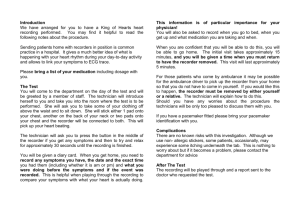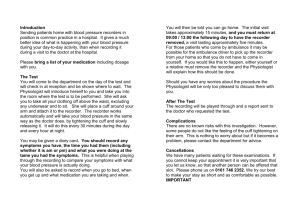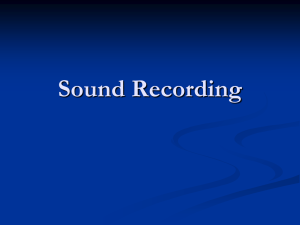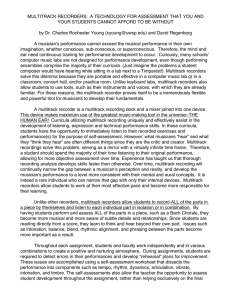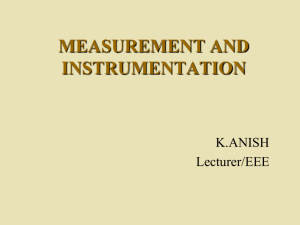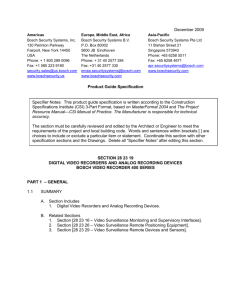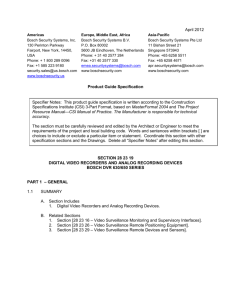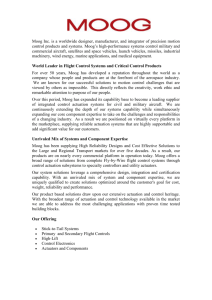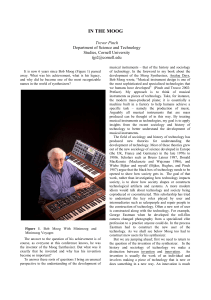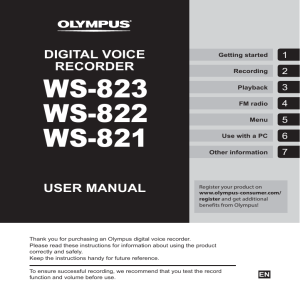Music Tech timeline
advertisement
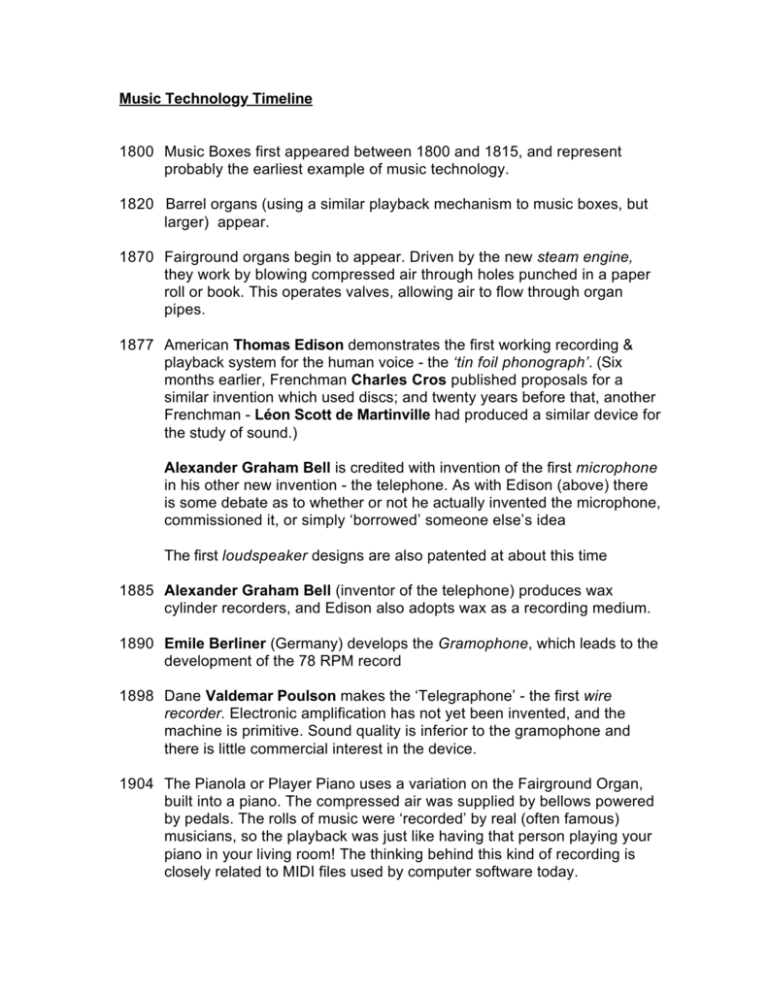
Music Technology Timeline 1800 Music Boxes first appeared between 1800 and 1815, and represent probably the earliest example of music technology. 1820 Barrel organs (using a similar playback mechanism to music boxes, but larger) appear. 1870 Fairground organs begin to appear. Driven by the new steam engine, they work by blowing compressed air through holes punched in a paper roll or book. This operates valves, allowing air to flow through organ pipes. 1877 American Thomas Edison demonstrates the first working recording & playback system for the human voice - the ‘tin foil phonograph’. (Six months earlier, Frenchman Charles Cros published proposals for a similar invention which used discs; and twenty years before that, another Frenchman - Léon Scott de Martinville had produced a similar device for the study of sound.) Alexander Graham Bell is credited with invention of the first microphone in his other new invention - the telephone. As with Edison (above) there is some debate as to whether or not he actually invented the microphone, commissioned it, or simply ‘borrowed’ someone else’s idea The first loudspeaker designs are also patented at about this time 1885 Alexander Graham Bell (inventor of the telephone) produces wax cylinder recorders, and Edison also adopts wax as a recording medium. 1890 Emile Berliner (Germany) develops the Gramophone, which leads to the development of the 78 RPM record 1898 Dane Valdemar Poulson makes the ‘Telegraphone’ - the first wire recorder. Electronic amplification has not yet been invented, and the machine is primitive. Sound quality is inferior to the gramophone and there is little commercial interest in the device. 1904 The Pianola or Player Piano uses a variation on the Fairground Organ, built into a piano. The compressed air was supplied by bellows powered by pedals. The rolls of music were ‘recorded’ by real (often famous) musicians, so the playback was just like having that person playing your piano in your living room! The thinking behind this kind of recording is closely related to MIDI files used by computer software today. 1907 American Lee de Forest invents the triode valve. This device is used to build electronic amplifiers. Prior to this date, amplification of sound was mechanical; Bell’s telephone used a battery and microphone to send a voice along a wire, but there was no electronic amplification. Singers with dance bands of the time sang into large metal horns (megaphones) to make themselves heard. When recording, they sang into the large end of a similar horn, which directed the sound of their voice onto a small diaphragm at the other end. This transmitted mechanical vibrations directly to the cutting needle. Using valve amplifiers, microphones could be used to drive disc cutting heads to produce records, and of course singers could be fed to loudspeakers, instead of singing into a 4 or 5 metre long megaphone! 1912 Lee de Forest combines the triode valve and the wire recorder. Although he met with technical success, the device was not so successful commercially. The fast speed of the wire (7 ft per second in some cases) meant that large impractical spools were required. Although some useable machines were produced using these methods, the sound quality was poor. 1929 German Fritz Pfleumer patents a method of coating paper tape with magnetic particles. 1930 Adolph Rickenbacker & George Beauchamp market the first electric guitars (fitted with electric pickups). 1935 Fritz Pfleumer and the AEG company produce the first viable tape recorder. This was adopted by the German radio authorities in 1938 and was used by the Germans for propaganda broadcasts during the war. Around the same time, AEG and the BASF company produce the first plastic recording tapes. Laurens Hammond produces the ‘Hammond Organ’. Using tonewheels driven by an electric motor, the Hammond organ is an electric instrument rather than an electronic one. Originally produced as a substitute for church organs, it soon found a place in jazz, gospel and rock music. 1936 First Television Broadcasts in London from the BBC (Black & White 405 lines). 1947 The invention of the Germanium Transistor by employees of Bell Telephone Laboratories. Transistors are much more robust than valves, have much lower operating voltages and waste less energy as heat. Les Paul modifies an Ampex tape recorder allowing him to record overdubs. “Lover” (Capitol Records) is the first example of multitrack recording as we know it today. Les Paul also made the first recordings using ‘close mic’ techniques. You thought he just designed guitars for Gibson? Nope! He built his own electric guitar (called The Log) about 1941. Years later, the Gibson guitar company developed a guitar based on his designs - the Les Paul. After producing the Les Paul for some time, Gibson ‘modernised’ the look if it. Les Paul hated the new instrument so much, he demanded that Gibson remove his name from it. The new shape was re-named the SG which stands for Solid Guitar. Les Paul’s real name is Lester William Polfus - so now you know! 1948 12 inch LP vinyl record introduced by Columbia Records 1954 EMT introduces plate reverb. In this electro-mechanical device, an audio signal is sent to a transducer (rather like a loudspeaker without the paper cone) attached to a large metal plate, which is suspended on elastic mounts. Transducers on the plate pick up the modified sound and convert it back into an electronic signal. Sony produces the first pocket transistor radio. Leo Fender invents the Stratocaster - the first commercially available solid bodied electric guitar. 1956 Stereo tape recordings appear 1962 Beatles release 'Love me do' in mono. 1963 The Mk1 Mellotron is produced - the first keyboard instrument to use the sound of real instruments. This is achieved by recording real instruments (string section, flutes, choirs etc) playing individual notes onto tape. The taped notes are cut into 8 second lengths, and mounted on a rack inside the Mellotron – one taped note under each key. When a key is pressed, the tape engages with the playback mechanism, and the sound plays back. The Mellotron can be heard on the Beatles ‘Strawberry Fields Forever’ (flutes); Led Zeppelin ‘Stairway to Heaven’ (flutes again); or more recently, the strings at the beginning of ‘Turn out the Light’ by Nelly Furtado. 1964 Philips produce the Compact Cassette. Until now, all tapes have been of the reel-to-reel type, which is not very robust or portable. 1965 Dolby Type A noise reduction system is introduced, to remove the inherent noise generated by all tapes on playback. Type A is a professional studio format, and works by splitting the audio into 5 separate frequency bands, and applying noise reduction to each band individually. Robert Moog shows elements of his early synthesizers. These would form the basis of the Moog Modular synthesizer, and eventually the classic MiniMoog. (Robert Moog died in July 2005.) 1969 Dolby-B noise reduction introduced. This is a cut down (and much less expensive) version of Type A, intended for use on domestic cassette recorders. 1970 Lexicon introduce the first digital delay line. A delay is the effect used for producing echo effects, although is was originally used for canceling the delay introduced heard in large PA systems, where front and rear speakers are some distance apart. 1971 The microprocessor CPU is invented. Until now, all electronic equipment has used discrete components to do particular jobs. Microprocessors can be programmed to perform any number of tasks. This results in lower manufacturing costs - as equipment no longer needs specialised components. 1975 EMT produces the first digital reverb. 1979 Sony introduces the Walkman. Tascam introduces the Portastudio - an affordable 4 track cassette multitrack recorder/mixer. The Australian Fairlight company produce the CMI or Computer Musical Instrument (normally referred to as the Fairlight). This instrument was capable of digital sampling (using 8 bit technology, 32k memory and 5.25 inch floppy disc storage). The cost of these primitive instruments at the time was about £30k - equivalent to about £140k in 2004! 1980 The first digital multitrack recorders are introduced. 1982 Philips & Sony launch the digital Compact Disc or CD. MIDI is standardized as the universal synthesizer interface. 1983 Yamaha produce the DX7 synthesizer. This uses FM additive synthesis, is 16 note polyphonic, and is equipped with the new MIDI interface. It also uses a system of programming called algorithms. 1985- The first “affordable” (under-£1000) digital reverbs are introduced. 1987 First consumer DAT recorders. 1992 Sony MiniDisc (MD) 1996 Experimental digital recordings are made at 24 bits and 96 kHz. 1997 DVD discs and players become commercially available. 2001 October 23, Apple introduces the iPod.
